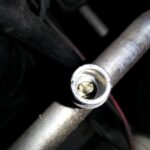Imagine the unthinkable: being trapped in your car after an accident. Whether your vehicle is submerged underwater or overturned, the seconds following such an event are critical. While these scenarios are, thankfully, rare, preparedness is paramount. In 2017 alone, approximately 8,000 vehicles were partially or fully submerged in accidents, and rollover crashes occurred even more frequently. Having a plan and equipping your car with an Owl Car Escape Tool could be the difference between life and death in such emergencies.
Recent research from AAA sheds light on the effectiveness of car escape tools, particularly when it comes to different types of vehicle glass. Their findings highlight a crucial distinction: not all car windows are created equal, and consequently, not all escape tools work on every type of glass.
Tempered vs. Laminated Glass: Know Your Windows
AAA’s comprehensive study rigorously tested six different car escape tools to assess their ability to break both tempered and laminated glass. The results were eye-opening. Only four of the tested tools successfully shattered tempered glass, the type commonly found in most car side windows. More concerningly, none of the tools were able to penetrate laminated glass. While the laminated glass cracked under pressure, it remained intact, effectively blocking escape. Interestingly, spring-loaded escape tools outperformed hammer-style tools in breaking tempered glass during repeated tests.
A car window label indicating the glass type. Knowing whether your car windows are tempered or laminated is crucial for emergency preparedness.
This distinction is becoming increasingly important as автомобили manufacturers incorporate laminated side windows into newer models for enhanced safety. Laminated glass, designed to prevent ejection during collisions, is now found in approximately one in three 2018 vehicle models.
“The push for increased vehicle safety has led to the greater use of laminated side windows, but the majority of vehicles still have at least one tempered glass window,” explains John Nielsen, managing director of Automotive Engineering and Repair for AAA. “Our research underscores that while vehicle escape tools can be effective in an emergency, their usefulness hinges on drivers knowing what type of side windows their vehicle has. Without this knowledge, valuable time could be wasted attempting to break glass that is virtually shatterproof with standard escape tools.”
Identifying Your Car Window Type
Determining whether your vehicle has tempered or laminated side windows is straightforward. Simply check the bottom corner of your side windows for a label. This label should clearly indicate the glass type – either “tempered” or “laminated.” If the label is missing or the information is unclear, AAA recommends contacting your vehicle manufacturer directly for clarification. It’s also important to note that some vehicles may have a combination of both types of glass, with laminated glass in the front side windows and tempered glass in the rear, for example.
Emergency Preparedness: Your S-U-R-E Escape Plan
Being prepared for a vehicle emergency dramatically increases your chances of survival. AAA strongly advises drivers to take the following steps to ensure they are ready to react effectively in a critical situation:
Pre-Emergency Preparation:
- Know Your Glass: Memorize whether your vehicle’s side windows are tempered or laminated. If your car has tempered windows, identify them as your primary escape points in an emergency. Remember, standard owl car escape tools are ineffective against laminated glass.
- Equip Your Vehicle: Keep an owl car escape tool readily accessible in your car. Choose a tool you are comfortable using and, ideally, have practiced with beforehand. Spring-loaded tools, often available as keychain attachments, are generally more effective on tempered glass. Consider mounting the tool on your dashboard or steering column for secure and immediate access during a collision.
- Develop an Escape Strategy: Create a clear escape plan and communicate it to all passengers in your vehicle. This pre-planning minimizes confusion and delays during an emergency. Also, consider a backup plan in case your escape tool is unusable or ineffective.
A spring-loaded car escape tool, a recommended type for breaking tempered glass in vehicle emergencies.
The S-U-R-E Escape Method:
In a vehicle emergency, remember the S-U-R-E method for a safe escape:
- Stay Calm: While time is critical, maintain composure to act decisively and effectively to ensure everyone’s safe exit.
- Unbuckle Seatbelts: Immediately release all seatbelts and ensure everyone is prepared to evacuate the vehicle.
- Roll Down or Break a Window: Attempt to roll down a window first. If submerged, be aware that water will rush in rapidly once a window is opened. If windows are inoperable and your car has tempered glass, use your owl car escape tool to break a side window for escape. If submerged and windows are laminated and cannot be broken, move to the rear of the vehicle or locate an air pocket. Wait until the vehicle is fully submerged and the pressure equalizes, which may then allow a door to be opened. Note that hammer-style escape tools can be significantly harder to use underwater compared to spring-loaded models.
- Exit the Vehicle: Quickly evacuate the vehicle and move to a safe location.
- Call 911: While calling emergency services is usually the first step, in situations like vehicle submersion or fire, prioritize immediate escape before contacting emergency services.
“Knowledge is a powerful tool in itself,” concludes Nielsen. “The more drivers understand about their vehicles, including the type of glass in their side windows, the better equipped they will be to handle vehicle emergencies effectively.”
For a comprehensive list of vehicles equipped with laminated side windows, please refer to this resource.
(Note: Please replace https://example.com/car-window-label.jpg and https://example.com/car-escape-tool.jpg with actual image URLs if you have relevant images to include. If using images from the original article or AAA report, ensure proper attribution and usage rights.)

